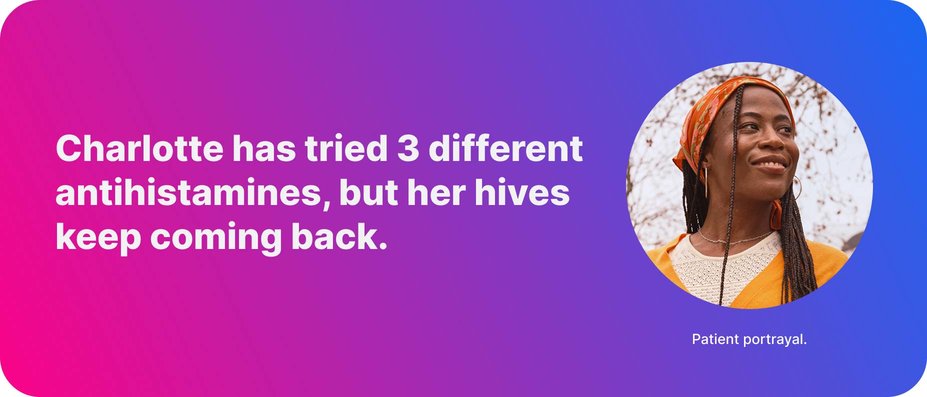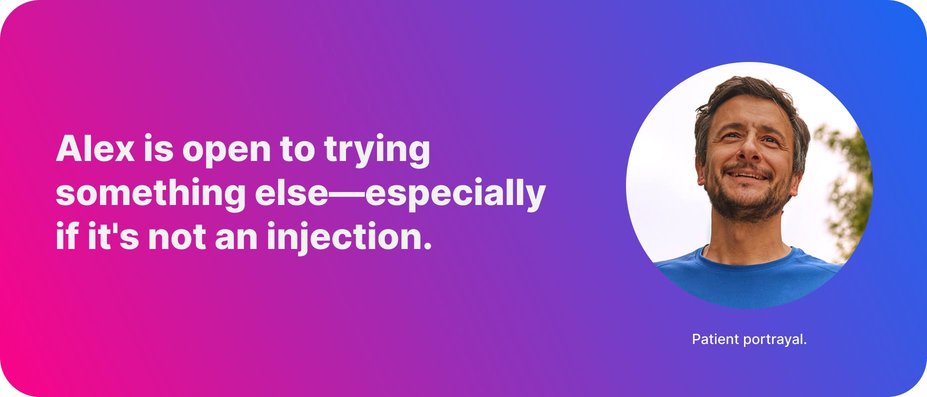
Identifying patients for RHAPSIDO® (remibrutinib)
See the characteristics that can help you identify appropriate patients for RHAPSIDO
Which of your patients are ready for the next step in their treatment plan? Every patient’s experience with CSU is different, but there are key characteristics that can help you identify when to start RHAPSIDO.
Meet Emma, Charlotte, and Alex*
*Hypothetical patient profiles.
Age: 25 years
Has been struggling with CSU symptoms for about 3 months
Symptoms
A couple of flares a week with unrelenting itch
When symptoms remain after 2 to 4 weeks on increased doses of antihistamines, urticaria treatment guidelines recommend advancing treatment1
Treatment
Has had her antihistamine dose increased on several occasions
Visited the ER during her most extreme flare; has been given steroids in the past
Burden
Reported having to cancel plans due to flares of hives and itch
RHAPSIDO is for your patients like Emma who remain symptomatic despite antihistamines and are proactively searching for more relief from their CSU symptoms.2
*Hypothetical patient profiles.
Age: 32 years
Has been struggling with CSU symptoms for around 6 months
Symptoms
3+ flares a week with intense itch; experiences occasional angioedema
RHAPSIDO was studied in a range of patient subgroups with varying disease severities, including patients with a history of angioedema3
Treatment
Has tried 3 different antihistamines, up-dosing by 4x each time
Burden
Constantly worries about her severe symptoms during unpredictable flares
Intense itch has left her scratching through the day and night on multiple occasions
RHAPSIDO is for your patients like Charlotte who struggle with CSU symptoms and want to try something else in addition to antihistamines.2
*Hypothetical patient profiles.
Age: 41 years
Has been struggling with CSU symptoms for 9 months
Symptoms
Consistently experiences at least 1 to 2 flares of hives and itch a week
After 2 to 4 weeks of persistent CSU symptoms on an increased dose of antihistamine treatment, continuing antihistamines alone is not recommended1
Treatment
Takes an increased dose of antihistamines every day
Despite his prolonged struggle, he prefers to stay on an oral regimen
Burden
Flares of hives and itch have caused him to miss or reschedule meetings
RHAPSIDO is for your patients like Alex who remain symptomatic despite antihistamines but want to stay on an oral regimen.2
Many patients take antihistamines but still struggle with CSU4,5
CSU symptoms can last months, years, or sometimes longer. It’s a long-term condition that requires continued management. When patients are unable to control their symptoms, having CSU can feel frustrating.4,6–8
average time to diagnosis7
of patients remain symptomatic despite antihistamines4
Even on increased doses of antihistamines, 1 in 2 patients continue to experience symptoms.
Patients with CSU experience a spontaneous occurrence of wheals or angioedema or both due to no known external triggers. You play a crucial role in helping them understand the facts.4,6,9,10



